The Fascinating Science: Explaining the Formation of Cutbacks-Emulsions
Cutbacks and emulsions are essential ingredients in various industries, but how exactly are they produced? To explain how cutbacks and emulsions are made, we must first understand the underlying chemistry that governs their formation. In the following sections, we will examine the composition and characteristics of these remarkable substances, as well as their numerous applications in everyday life.
Content Overview
What Are Cutbacks and Emulsions?
Cutbacks are a type of asphalt product, created by blending asphalt cement with a petroleum-based solvent. This process reduces the viscosity of the asphalt, making it more fluid and workable. Cutbacks are mainly used in road construction, where they serve as a binder for aggregates in the pavement.
Emulsions, on the other hand, are mixtures of two immiscible liquids (liquids that do not mix), such as oil and water, stabilized by an emulsifying agent. The emulsifying agent forms a protective layer around one of the liquids, preventing them from separating. Emulsions are widely used in various industries, including food, pharmaceuticals, and cosmetics, such as paraffin emulsion, as well as in construction, including emulsion bitumen.
The Science Behind Cutbacks
To explain how cutbacks are made, it is essential to understand the chemistry of asphalt. Asphalt is a complex mixture of hydrocarbons, including asphaltenes, resins, and oils. The asphaltenes provide rigidity, while the resins and oils contribute to the material’s flexibility and workability.
Cutbacks are created by mixing asphalt cement with a petroleum-based solvent, which reduces the viscosity of the asphalt. The solvent breaks up the complex hydrocarbon structure, allowing the material to become more fluid. Once the cutback has been applied and the solvent evaporates, the asphalt returns to its original, more viscous state.
The Science Behind Emulsions
Emulsions are formed when two immiscible liquids are mixed, with one liquid dispersed as tiny droplets throughout the other. To understand how emulsions are made, we must first explore the concept of surface tension. Surface tension is a property of liquids that causes the surface to act like an elastic membrane. In the case of emulsions, this property keeps the two liquids from mixing.
Emulsifying agents, also known as surfactants, are added to reduce the surface tension between the two liquids, allowing them to mix. These agents have a dual nature, with one part being hydrophilic (water-loving) and the other part being lipophilic (oil-loving). The surfactant molecules surround the droplets of one liquid, preventing them from coalescing and separating from the other liquid.
Applications of Cutbacks and Emulsions
Cutbacks are primarily used in road construction, as they serve as an essential binder for aggregates in the pavement. They are also employed in waterproofing and insulation materials.
Emulsions, on the other hand, have a wide range of applications across various industries. In the food industry, they are commonly found in products such as mayonnaise, salad dressings, and ice cream, where they help create a stable and smooth texture. In cosmetics, emulsions form the basis of creams, lotions, and serums, providing a consistent and easily absorbed product. The pharmaceutical industry also utilizes emulsions for drug delivery systems, allowing for a controlled release of active ingredients.
Types of Emulsions
There are two primary types of emulsions: oil-in-water (O/W) and water-in-oil (W/O). In an O/W emulsion, oil droplets are dispersed throughout a continuous water phase, whereas in a W/O emulsion, water droplets are dispersed throughout a continuous oil phase. The type of emulsion formed depends on the ratio of the two liquids and the choice of emulsifying agent. Some examples of O/W emulsions include milk and mayonnaise, while W/O emulsions are found in products like butter and certain skin creams.
Environmental Considerations
While cutbacks and emulsions are indispensable in many industries, it’s crucial to consider their environmental impact. For instance, cutbacks release volatile organic compounds (VOCs) during the evaporation process, which contribute to air pollution. To address this concern, alternative products such as polymer-modified bitumen and water-based emulsions are being developed and used.
In the case of emulsions, biodegradable and environmentally friendly surfactants are being researched to minimize their ecological footprint. By choosing sustainable alternatives, industries can continue to benefit from the versatility of cutbacks and emulsions while reducing their environmental impact.
In conclusion, understanding how cutbacks and emulsions are made provides valuable insight into the science and applications of these versatile substances. With numerous uses in various industries, cutbacks and emulsions play a significant role in our everyday lives. As we continue to develop and adopt more sustainable alternatives, these products will remain an essential part of modern technology and innovation.
Purchasing from Petro Naft
For more detailed information and to purchase the products discussed in this article, please visit the dedicated products page below. Alternatively, use the various communication channels provided on our site to register your purchase inquiry or take advantage of our expert guidance.
Prepared by the PetroNaft Co. research team.

